John Sturgus Bastin: A Memoir
The late Dr John Bastin was the leading authority on Stamford Raffles, having published more than 20 books and many essays on Raffles.
By Kwa Chong Guan
The eminent historian Dr John Sturgus Bastin (1927–2024) lived much, if not most of his life, with Thomas Stamford Raffles. His first book was based on his 1954 Leiden University doctoral dissertation on Raffles’ ideas on the land rent system in Java.1 His last book was on the letters that Raffles wrote to his sister Mary Ann Flint published in 2021.2 Within the span of those 67 years, Bastin published some 20 other books and dozens of essays, all in one way or another relating to Raffles and his world in the British East India Company.
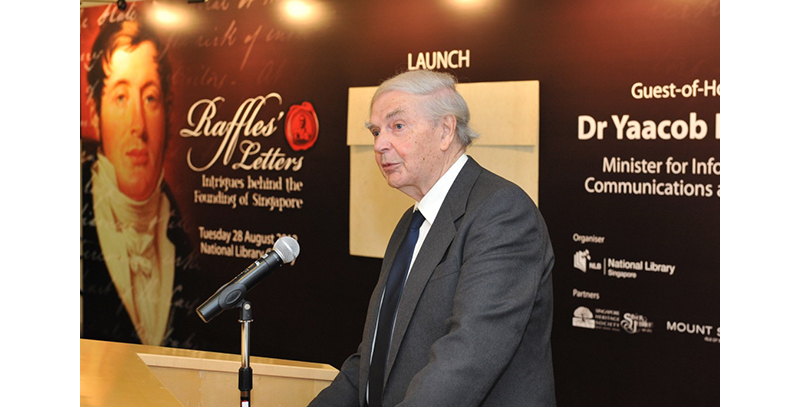
In addition to being a historian, Bastin was a bibliophile. He systematically collected anything and everything on Raffles and his wide interests that ranged from antiquities to natural history. The National Library of Singapore is proud and privileged to have acquired Bastin’s library of over 5,000 books relating to Raffles and Singapore/Southeast Asia in 2015. These items form part of the John Bastin Collection at the National Library.
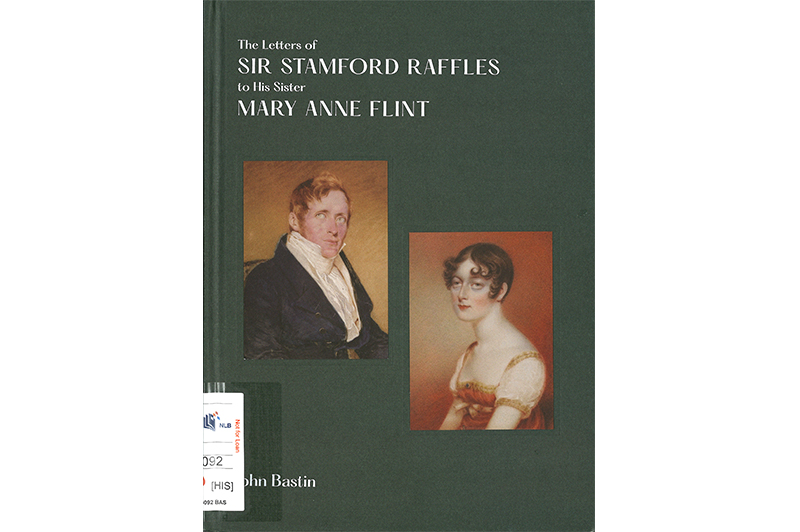
Foundation Professor of History at the University of Malaya
Bastin was born on 30 January 1927 in Melbourne, Australia. His great-grandfather had been born in England but migrated to Australia after the Victorian gold rush. After obtaining a first-class honours degree in history and then a master of arts degree from the University of Melbourne, Bastin was awarded a postgraduate scholarship in 1951 to study at Balliol College, University of Oxford.
Bastin’s interest in Raffles was first sparked when he read an article on Indonesia by Harry J. Benda of Yale University (who later became his friend), which included a brief reference to Raffles’ administration in Java. Bastin thought this might prove an interesting topic for academic research. In 1954, he defended his University of Leiden doctoral dissertation on Raffles’ ideas on the land rent system in Java and was awarded the degree of Doctor of Literature and Philosophy. In 1955, Bastin submitted his doctoral dissertation on Raffles’ policies in Java and Sumatra and was awarded the degree of Doctor of Philosophy from the University of Oxford. The thesis was subsequently published by Oxford University Press in 1957.3
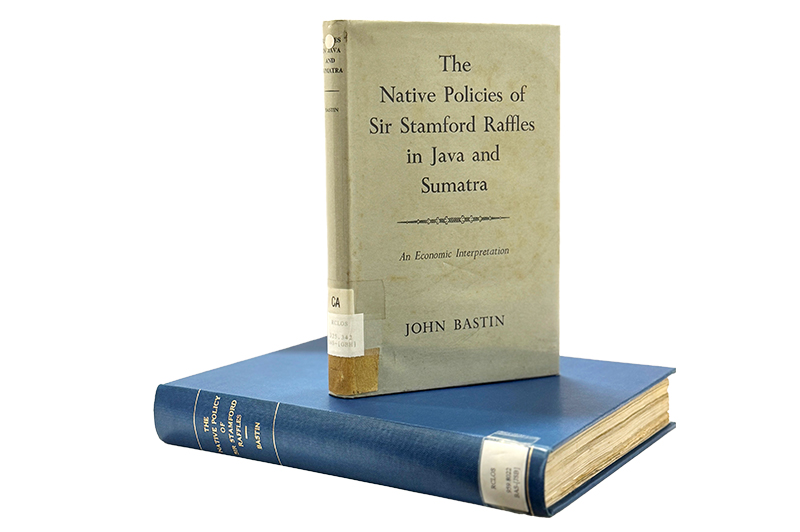
Bastin’s lifelong fascination with Raffles led him to develop a long relationship with Singapore and Malaya, starting when he was elected Foundation Professor of History at the newly established University of Malaya campus in Kuala Lumpur in 1959. Bastin arrived to head a department of one: the diplomatic historian Alastair Lamb (1930–2023) who, while in Kuala Lumpur, turned his interest to the archaeological investigation of port settlements in the isthmus and the Bujang Valley in Kedah. In May 1959, Bastin and Lamb were joined by Wang Gungwu (currently University Professor at the National University of Singapore and professor emeritus at the Australian National University) after he completed his PhD from the University of London.
Bastin’s inaugural lecture at the University of Malaya in 1959 was a combative response to what he perceived as a disturbing emerging trend in the writing of the region’s history among his Singapore colleagues headed by K.G. Tregonning (1923–2015), who succeeded C.N. Parkinson (1909–93) as Raffles Professor of History in June 1959. Tregonning was deeply influenced by the English translation of essays by the young Dutch scholar-civil servant, J.C. van Leur, who was tragically killed in action in World War II. Van Leur had argued that the writing of Indonesian history should shift from looking at Indonesia “from the deck of ramparts of the fortress, the high gallery of the trading house” to looking at Indonesia’s history from that of the palaces of the Javanese rulers the Dutch were trying to relate to.4
Tregonning wrote: “Asia, not the European in Asia, must be our theme, and suddenly, if you think of that, it makes the Portuguese and the Dutch most insignificant, and almost extraneous… they were a few heretical fish in a Muslim sea and… did not affect Asia much.”5
Bastin was evidently troubled at this effort to write out the Westerners from Asian history. As he concluded his inaugural lecture, he said: “The exact historical significance of Westerners in the Asian scene may be debated, but it would be a foolhardy historian who would regard them as extraneous.”6 The issue of whether it is possible to write Asian history from the viewpoint of Asia was, as Bastin noted, the subject of “a rather one sided debate” in the Journal of Southeast Asian History edited by Tregonning.7 I followed this controversy as a young undergraduate at the former University of Singapore. It is a controversy which, I argue, continues to challenge a younger generation of historians.
In his inaugural lecture, Bastin argued that a major issue in writing Asian history from an Asian perspective is that much of the source materials are in Western languages and comprehensible only to a Western historical framework which establishes the historical narrative even before it is written.
Today, a younger generation of scholars continues to grapple with the issues Bastin had highlighted some 60 years earlier. They are exploring how a close “against the grain” or “along the grain” reading of archived colonial records can lead us to a more nuanced understanding of how Asian actors interacted with Western actors and among themselves. For example, Benjamin J.Q. Khoo, the National Library’s 2020/21 Lee Kong Chian Research Fellow, revealed how a Dutch-Bugis misunderstanding over a royal wedding in 1820 led to an uprising among the Bugis community in Riau and their departure for Singapore where they established themselves in a Bugis kampong in the estuary of the Kallang River.8
Bastin was apparently sufficiently piqued by the adverse response of his colleagues to his inaugural lecture that he drafted a longer reply pointing to issues of personality, or lack thereof, in the reinterpretation of Malayan history. In this later essay, Bastin argued that we are more familiar with Western actors like Raffles, who left us volumes of reports and correspondence. But we know much less about Asian actors, the Malay sultans who left few, if any, records and are shadowy personalities.9 But this was after he had resigned from his professorship and deanship at the University of Malaya to go on to a lectureship in Modern History of Southeast Asia at the School of Oriental and African Studies (SOAS) in the University of London in 1963. (At the University of Malaya, he was succeeded by Wang Gungwu as Professor of History.)
Bastin never revealed or discussed why he resigned from the University of Malaya for SOAS where he remained for the rest of his academic career, retiring as an Emeritus Reader. Possibly he may have tired of the debate about how to write Asian history and just wanted to get on with writing history as he understood it.
The Bibliophile
Bastin collected books, reports and records about Raffles and his world, which he was researching. Most scholars view books, archived records and textual material as sources of information to be verified and collated to become historical evidence for the reconstruction of the past. For Bastin, these publications and records were more than source materials, they were historical artefacts in their own right. I realised this in early 1994 when Bastin invited me to lunch at his home in Eastbourne, East Sussex, while I was on a visit to the British Museum and British Library to seek their support for an exhibition, “Raffles Reviewed”, that our National Museum was curating. Needless to say, I accepted the invitation with alacrity.
The highlight of my visit was Bastin showing me around his library. He showed me his copy of the first edition of Raffles’ The History of Java, published in 1817, and copies of all the later reprints of the book.10 Bastin had also managed to acquire copies of the various pamphlets and reports Raffles had written and printed. He had a copy of the extremely rare “Statement of Services” Raffles wrote in defence of his record of work for the East India Company and had privately printed in 1824. There were shelves of hundreds, if not thousands, of “antiquarian” and more recent books about Raffles and his world. All these books were carefully shelved and displayed like artefacts in a museum exhibition.
My attention was drawn to a locket carefully displayed on a bookcase and asked what it was. Bastin picked up the locket and very carefully opened it to show me a lock of wispy blond hair, whispering “Raffles’ hair” (in 19th century England, it was common to preserve locks of hair of a deceased in a locket or keepsake as a memento).
The depth and extent of Bastin’s library about Raffles and his world left me in awe. I could not have imagined that some 20 years later, Singapore’s National Library would have the opportunity to acquire it, and I would be a member of the team to do so.11
Personalities and the Writing of History
Bastin the bibliophile merges into Bastin the historian in that a significant number of his writings were on the historically significant publications of the 19th century which, as the editor of the Oxford in Asia Historical Reprints, he would have recommended be reprinted.
Among the most significant reprints Oxford published was Raffles’ History of Java, which today has become a much sought-after rare book. Bastin provided a meticulously footnoted 17-page introduction to the reprint, reconstructing the circumstances under which Raffles wrote the book and its production history. Bastin wrote similarly detailed introductions to Oxford reprints of Sophia Raffles’ memoir of her husband, Memoir of the Life and Public Services of Sir Thomas Stamford Raffles, and William Marsden’s The History of Sumatra.12
This, then, was Bastin’s forte: micro studies based on close reading of archived records, printed accounts and reports by historical actors and other contemporaneous observers of events. This included drawings and prints of Indonesia and, of course, people, especially Raffles and his circle of friends and contemporaries. Bastin’s large-format transcription and editing of Letters and Books of Sir Stamford Raffles and Lady Raffles is a model of how dry historical records and books can be made fascinating and impressive.13
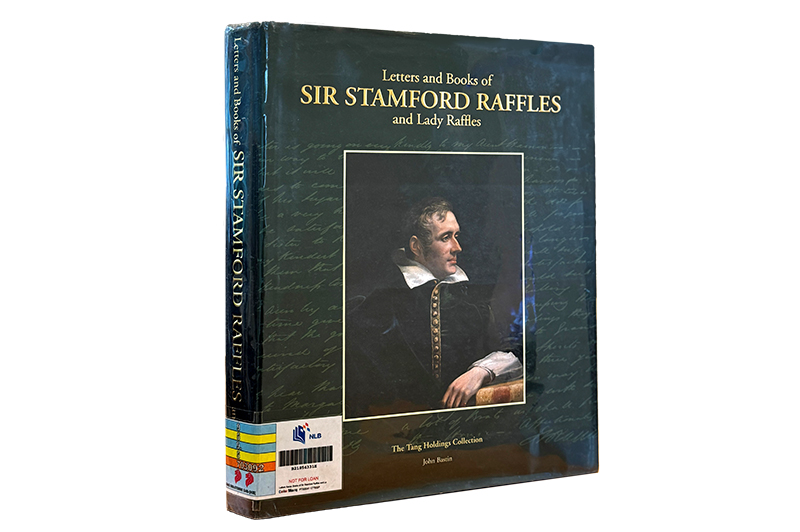
In Bastin’s transcription of the correspondence between Raffles and the Governor-General of India, the Marquess of Hastings, he provides us with a more nuanced understanding of Raffles’ claim to be the first to recognise the strategic location of Singapore for an East India Company settlement.14 We are now aware that it was the Marquess of Hastings who directed Raffles to search for a location at the southern end of the Straits of Melaka for this proposed British station, rather than, as Raffles was suggesting, somewhere on the coast of Borneo, in the vicinity of Sambas or Pontianak in western Borneo, or even possibly the island of Balambangan island off the north coast of Sabah where the East India Company had had a settlement since 1762.
It would appear that for Bastin, the study of history is not about great men and their doings, but being able to put ourselves into the shoes of historical actors to understand why they did what they did. Bastin cites the Oxford philosopher, historian and archaeologist R.G. Collingwood, who argued that “for science, the event is discovered by perceiving it… For history the object to be discovered is not the mere event, but the thought expressed in it. To discover that thought is already to understand it”.15
Bastin’s careful transcription and editing of archival records and historical publications have helped us to achieve a deep understanding of what was in the minds of Raffles and his superiors, friends and colleagues. In these endeavours, Bastin was thoroughly objective, but not necessarily neutral as can be seen in his treatment of William Farquhar, the first resident of Singapore (1819–23), and John Crawfurd, who succeeded Farquhar as Resident (1823–26), in Bastin’s 2019 book, Sir Stamford Raffles and Some of His Friends and Contemporaries.16
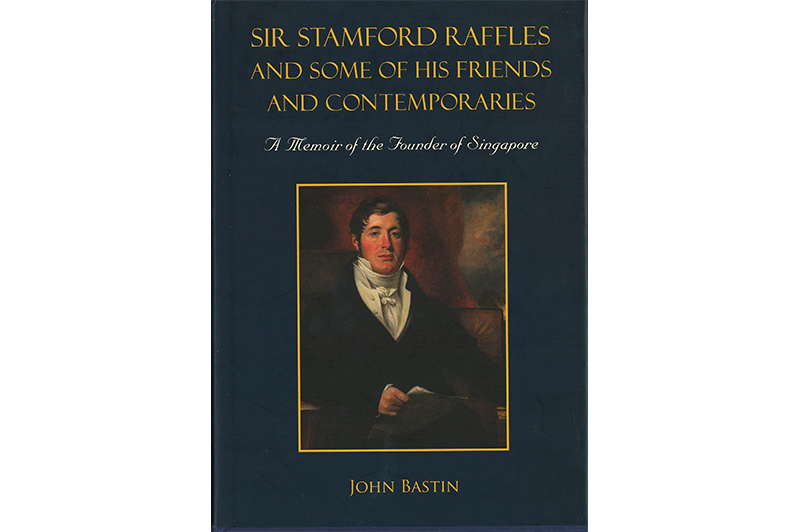
When Bastin showed me a draft of this manuscript, I looked at the contents of the book and noticed that it mentioned the Scottish poet and Orientalist John Leyden, the Danish surgeon and naturalist Nathaniel Wallich, and even Raffles’ Malay clerk John Leyden Siami. I asked Bastin why he did not include Farquhar and Crawfurd as they were contemporaries of Raffles and had worked closely with him. Bastin’s short and sharp reply to me was “they were not friends of Raffles”.
Working with Bastin
Singapore’s National Museum and National Library were fortunate that Bastin appeared to have considered us friends of Raffles, and he readily shared his encyclopedic knowledge of Raffles and his world whenever we approached him for help and advice. In 1993, Bastin wrote an eight-page pamphlet for the National Museum titled “The Farquhar Silver Epergne Presented by the Chinese Inhabitants of Singapore 1824”. The museum had acquired the silver epergne (a type of table centrepiece used for holding fruit, flowers or candles) in a private sale from its owner, Captain David John Farquhar Atkins, R.N., a direct descendant of Farquhar. For the museum’s 1994 exhibition, “Raffles Reviewed”, Bastin wrote a five-page fold-out brochure on Raffles with a detailed timeline of Raffles’ life. The brochure remains a succinct reference on Raffles up to today.
But the museum’s major collaboration with Bastin was the production of a very large-format catalogue of Farquhar’s collection of natural history drawings that Goh Geok Khim, founder of brokerage firm GK Goh, had successfully bidded for at a 1993 Sotheby’s auction and donated to the National Heritage Board in 1996. Bastin also wrote a detailed essay, “William Farquhar; His Life and Interest in Natural History”, for the catalogue.17
The National Library has been privileged to work closely with Bastin, especially in our acquisition of his unmatched library of rare and heritage materials in 2015. Bastin subsequently donated his personal archives containing his research papers and personal correspondences, which are useful primary source materials on the study of Raffles and Singapore/Southeast Asia. The National Library received the archives in two tranches, the first in August 2019 and the second in January 2022.
In 2016, the library was given the opportunity to publish Bastin’s book, The Family of Sir Stamford Raffles, co-authored with Julie Weizenegger.18 Before that, the library had published the private exchanges between Raffles and Hastings, edited by Bastin, on the founding of Singapore. The publication of Raffles’ correspondence with the 1st Marquess of Hastings, the Governor-General of India between 1813 and 1823, was the outcome of an exhibition at the National Library in 2012.19 The exhibition showcased 13 letters in the private papers of Lord Hastings which are now in The Bute Collection at Mount Stuart, Isle of Bute, Scotland, and exhibited through the generosity of the 7th Marquess of Bute.
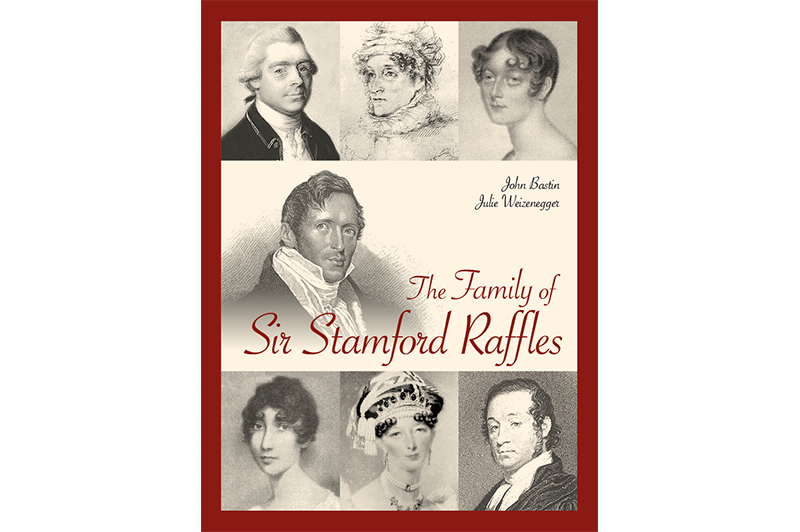
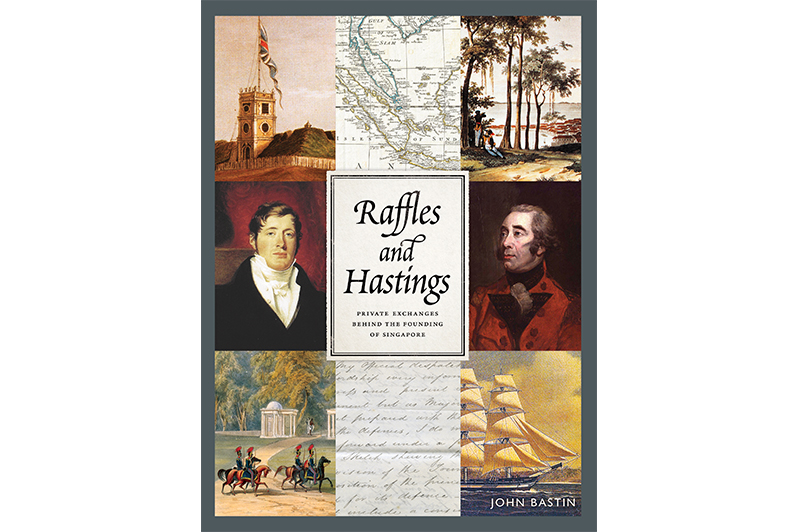
Those of us at the National Museum and National Library who had the occasion to work with Bastin, as I had, found him a precise and exacting writer. He knew exactly what he wanted to say and how to say it. Editing Bastin was always a challenge.
Bastin never wrote the definitive biography of Raffles which many of us expected. Instead, what Bastin left us was what he termed “an ‘alternative’ biographical account of Raffles, as seen through the lives of his friends and contemporaries”.20 We are delighted that Bastin chose to publish this “alternative” biography of Raffles, Sir Stamford Raffles and Some of His Friends and Contemporaries: A Memoir of the Founder of Singapore, in the bicentenary year of Raffles’ arrival in Singapore.
Bastin passed away peacefully in his home in Eastbourne on 7 August 2024, aged 97. He is survived by his wife Rita, and four children, Christopher, Jennifer, Mark and Marianne.
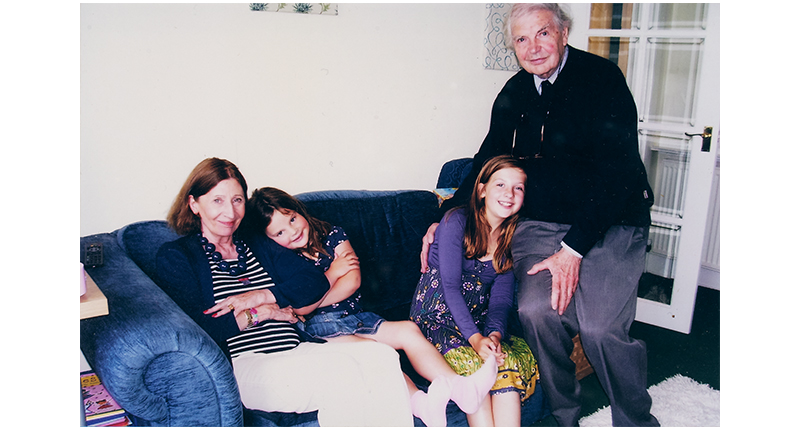
• Bastin, John Sturgus. “Raffles’ Ideas on the Land Rent System in Java and the Work of the Mackenzie Land Tenure Commission.” Verhandelingen van het Koninklijk Instituut voor Taal, Land- en Volkenkunde 14. ‘s-Gravenhage: Martinus Nijhoff, 1954. (From JSTOR via NLB’s eResources website)
• Bastin, John Sturgus. “The Native Policy of Sir Stamford Raffles” (PhD diss., Oxford University, 1955). (From National Library, Singapore, call no. RCLOS 959.8022 BAS-[JSB])
• Bastin, John Sturgus. The Native Policies of Sir Stamford Raffles in Java and Sumatra; An Economic Interpretation. Oxford: Clarendon Press, 1957. (From National Library, Singapore, call no. RCLOS 325.342 BAS-[JSB])
• Bastin, John Sturgus, ed. The Journal of Thomas Otho Travers 1813–1820. Memoirs of the Raffles Museum no. 4, May 1957. Singapore: Authority; Printed by A.C. Banfield, Government Printer, 1960. (From National Library, Singapore, call no. RCLOS 920.009034 TRA-[JSB])
• Bastin, John Sturgus. Essays on Indonesian and Malayan History. Monographs on Southeast Asian Subjects no. 2. Singapore: Eastern Universities Press, 1961. (From National Library, Singapore, call no. RDTYS 991 BAS)
• Bastin, John Sturgus and R. Roolvink, eds. Malayan and Indonesian Studies: Essays Presented to Sir Richard Winstedt on His Eighty-fifth Birthday. Oxford: Clarendon Press, 1964. (From National Library, Singapore, call no. RCLOS 959.5 BAS)
• Bastin, John Sturgus. The British in West Sumatra (1685–1825): A Selection of Documents, Mainly from the EIC Records Preserved in the India Office Library, Commonwealth Relations Office. Kuala Lumpur: University of Malaya Press, 1965. (From National Library, Singapore, call no. RCLOS 325.921 BAS-[JSB])
• Bastin, John Sturgus and Robin W. Winks, comps. Malaysia: Selected Historical Readings. Kuala Lumpur: Oxford University Press, 1966. (From National Library, Singapore, call no. RSING 959.5 BAS-[JSB])
• Bastin, John Sturgus, ed. The Emergence of Modern Southeast Asia, 1511–1957. Englewood Cliffs, N.J., Prentice-Hall, 1967. (From National Library, Singapore, call no. RCLOS 959 BAS-[JSB])
• Bastin, John Sturgus and Harry J. Benda. A History of Modern Southeast Asia: Colonialism, Nationalism, and Decolonization. Singapore: Federal Publications, 1968. (From National Library, Singapore, call no. RCLOS 959 BAS-[JSB])
• Bastin, John Sturgus and Mildred Archer. The Raffles Drawings in the India Office Library, London. Kuala Lumpur: Oxford University Press, 1978. (From National Library, Singapore, call no. RCLOS 741.959 ARC-[JSB])
• Bastin, John Sturgus and Pauline Rothagi. Prints of Southeast Asia in the India Office Library: The East India Company in Malaysia and Indonesia, 1786–1824. London: Her Majesty's Stationery Office, 1979. (From National Library, Singapore, call no. RDLKL 769.49959503 BAS-[JSB])
• Bastin, John Sturgus and Bea Brommer. Nineteenth Century Prints and Illustrated Books of Indonesia With Particular Reference to the Print Collection of the Tropenmuseum, Amsterdam. Utrecht: Spectrum Publishers, 1979. (From National Library, Singapore, call no. RSEA 769.49959802 BAS-[JSB])
• Bastin, John Sturgus, comp. Travellers’ Singapore: An Anthology. Kuala Lumpur: Oxford University Press, 1994. (From National Library, Singapore, call no. RSING 959.5705 TRA-[JSB])
• Bastin, John Sturgus. Olivia Mariamne Raffles. Singapore: Landmark Books, 2002. (From National Library, Singapore, call no. RSING 959.5703092 BAS-[HIS])
• Bastin, John Sturgus. Sophia Raffles. Singapore: Landmark Books, 2002. (From National Library, Singapore, call no. RSING 959.5703092 BAS-[HIS])
• Bastin, John Sturgus. Letters and Books of Sir Stamford Raffles and Lady Raffles: The Tang Holdings Collection of Autograph Letters and Books of Sir Stamford Raffles and Lady Raffles. Singapore: Editions Didier Millet, 2009. (From National Library, Singapore, call no. RSING 959.5703092 BAS-[JSB])
• Bastin, John Sturgus. The Founding of Singapore 1819: Based on the Private Letters of Sir Stamford Raffles to the Governor-General and Commander-in-Chief in India, the Marguess of Hastings, Preserved in the Bute Collection at Mount Stuart, Isle of Bute, Scotland. Singapore: National Library Board, 2012. (From National Library, Singapore, call no. RSING 959.5703 BAS-[JSB])
• Bastin, John Sturgus. Raffles and Hastings: Private Exchanges Behind the Founding of Singapore. Singapore: National Library Board Singapore and Marshall Cavendish Editions, 2014. (From National Library, Singapore, call no. RSING 959.5703 BAS-[JSB])
• Bastin, John Sturgus and Julie Weizenegger. The Family of Sir Stamford Raffles. Singapore: National Library Board Singapore and Marshall Cavendish Editions, 2016. (From National Library, Singapore, call no. RSING 959.57030922 BAS-[HIS])
• Bastin, John Sturgus. Sir Stamford Raffles and Some of His Friends and Contemporaries: A Memoir of the Founder of Singapore. Singapore: World Scientific Publishing Co. Pte Ltd, 2019. (From National Library, Singapore, call no. RSING 959.5703092 BAS-[HIS])
• Bastin, John Sturgus. The Letters of Sir Stamford Raffles to His Sister Mary Anne Flint: Together With the Letters of Lady Raffles. Singapore: National Museum of Singapore, 2021. (From National Library, Singapore, call no. RSING 959.5703092 BAS-[HIS])
Kwa Chong Guan is a former member of the National Library Board and chair of its National Library Acquisition Committee. For his services to the National Library, he was awarded a Public Service Medal in the National Day Awards 2020. He was earlier a member of the National Heritage Board and chair of the National Archives Advisory Committee. He was the last director of the old National Museum which he led through a strategic planning process that expanded the museum into the Singapore History Museum (now the National Museum of Singapore), the Asian Civilisations Museum and the Singapore Art Museum.
NOTES
-
John Sturgus Bastin, “Raffles’ Ideas on the Land Rent System in Java and the Work of the Mackenzie Land Tenure Commission,” Verhandelingen van het Koninklijk Instituut voor Taal, Land- en Volkenkunde 14 (‘s-Gravenhage: Martinus Nijhoff, 1954). (From JSTOR via NLB’s eResources website) ↩
-
John Sturgus Bastin, The Letters of Sir Stamford Raffles to His Sister Mary Anne Flint: Together With the Letters of Lady Raffles (Singapore: National Museum of Singapore, 2021). (From National Library, Singapore, call no. RSING 959.5703092 BAS-[HIS]) ↩
-
John Sturgus Bastin, “The Native Policy of Sir Stamford Raffles: A Thesis Submitted for the Degree of Philosophy” (PhD diss., Oxford University, 1955). (From National Library, Singapore, call no. RCLOS 959.8022 BAS-[JSB]); John Sturgus Bastin, The Native Policies of Sir Stamford Raffles in Java and Sumatra: An Economic Interpretation (Oxford: Clarendon Press, 1957). (From National Library, Singapore, call no. RCLOS 325.342 BAS-[JSB]) ↩
-
Jacob Cornelis van Leur, Indonesian Trade and Society: Essays in Asian Social and Economic History; Selected Studies on Indonesia (The Hague: Published for the Royal Tropical Institute, Amsterdam, by W. van Hoeve, 1955), 261. (From National Library, Singapore, call no. RCLOS 959.8 LEU) ↩
-
K.G. Tregonning, “A New Approach to Malayan History,” Straits Times, 21 November 1958, 8; K.G. Tregonning, “Look at Our Story from the Inside, Not from Outside,” Straits Times, 24 November 1958, 6. (From NewspaperSG) ↩
-
John Sturgus Bastin, “The Western Element in Modern Southeast Asian History,” in Essays on Indonesian and Malayan History (Singapore, Eastern Universities Press, 1961), 18. (From National Library, Singapore, call no. RDTYS 991 BAS) ↩
-
John Sturgus Bastin, “Problems of Personality in the Reinterpretation of Modern Malayan History,” in Malayan and Indonesian Studies; Essays Presented to Sir Richard Winstedt on His Eighty-Fifth Birthday, ed. John Sturgus Bastin and R. Roolvink (Oxford: Clarendon Press, 1964), 144. (From National Library, Singapore, call no. RCLOS 959.5 BAS) ↩
-
Benjamin J.Q. Khoo, “A Royal Wedding Gone Wrong: The 1820 Uprising in Riau That Brought the Bugis to Singapore,” BiblioAsia 18, no. 2 (July–September 2022): 4–9. ↩
-
Bastin, “Problems of Personality in the Reinterpretation of Modern Malayan History,” 141–51. ↩
-
Thomas Stamford Raffles, The History of Java, vol. 1 and vol. 2 (London: John Murray, 1830). (From National Library Online) ↩
-
J.B. Stanley, “The Bastin Collection on Raffles,” Biblioasia 12, no. 1 (April–June 2016): 60–64. ↩
-
Sophia Raffles, Memoir of the Life and Public Services of Sir Thomas Stamford Raffles (Singapore: Oxford University Press, 1991). (From National Library Online); William Marsden, The History of Sumatra (Singapore: Oxford University Press, 1986). (From National Library, Singapore, call no. RSING 959.81 MAR) ↩
-
John Sturgus Bastin, Letters and Books of Sir Stamford Raffles and Lady Raffles: The Tang Holdings Collection of Autograph Letters and Books of Sir Stamford Raffles and Lady Raffles (Singapore: Editions Didier Millet 2009). (From National Library, Singapore, call no. RSING 959.5703092 BAS-[JSB]) ↩
-
John Sturgus Bastin, Raffles and Hastings: Private Exchanges Behind the Founding of Singapore (Singapore: National Library Board Singapore and Marshall Cavendish Editions, 2014). (From National Library, Singapore, call no. RSING 959.5703 BAS-[JSB]) ↩
-
Robin George Collingwood, The Idea of History, rev. ed. W.J. van der Dussen (Oxford: University Press, 1993), 214, 283. ↩
-
John Sturgus Bastin, Sir Stamford Raffles and Some of His Friends and Contemporaries: A Memoir of the Founder of Singapore (Singapore: World Scientific Publishing Co. Pte Ltd, 2019). (From National Library, Singapore, call no. RSING 959.5703092 BAS-[HIS]) ↩
-
William Farquhar, Natural History Drawings: The Complete William Farquhar Collection: Malay Peninsula, 1803–1818 (Singapore: Editions Didier Millet: National Museum of Singapore, repr. 2015, 2010). (From National Library, Singapore, call no. RCLOS 508.0222 FAR-[JSB]) ↩
-
John Sturgus Bastin and Julie Weizenegger, The Family of Sir Stamford Raffles (Singapore: National Library Board Singapore and Marshall Cavendish Editions, 2016). (From National Library, Singapore, call no. RSING 959.57030922 BAS-[HIS]) ↩
-
John Sturgus Bastin, The Founding of Singapore 1819: Based on the Private Letters of Sir Stamford Raffles to the Governor-General and Commander-in-Chief in India, the Marguess of Hastings, Preserved in the Bute Collection at Mount Stuart, Isle of Bute, Scotland (Singapore: National Library Board, 2012). (From National Library, Singapore, call no. RSING 959.5703 BAS-[JSB]) ↩
-
Bastin, Sir Stamford Raffles and Some of His Friends and Contemporaries, vi. ↩

